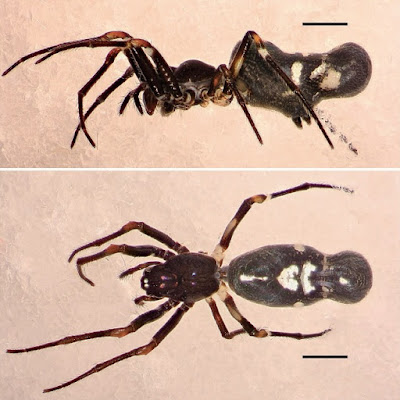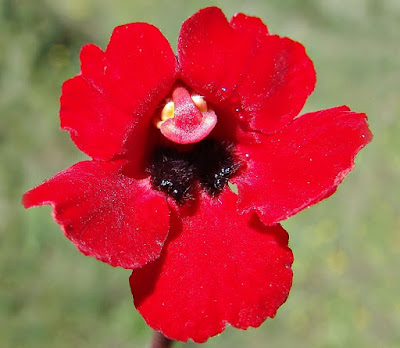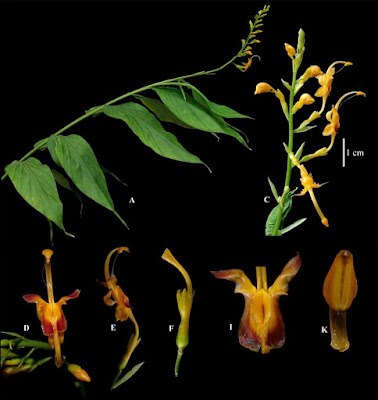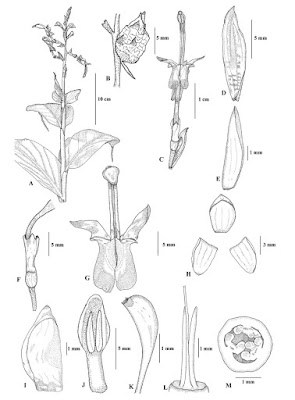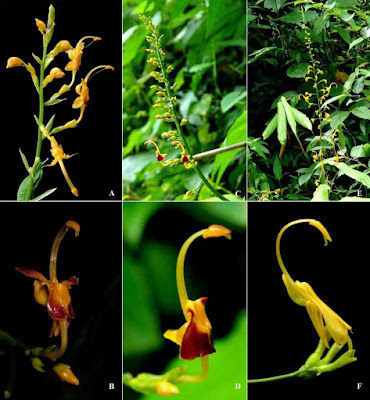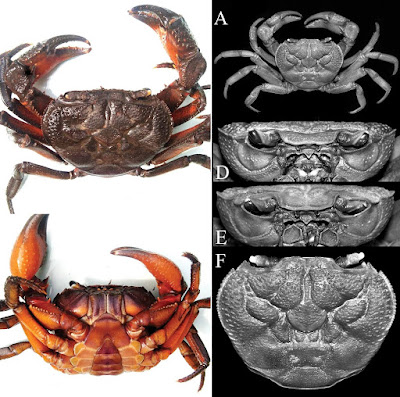[Most Recent Entries] [Calendar View]
Thursday, January 3rd, 2019
| Time | Event | ||||||||
| 3:06a | [Arachnida • 2018] Cyclosa bulla • A New Species of Cyclosa (Araneae: Araneidae) from Southeast Asia
Abstract A new species of Cyclosa is described under the name of Cyclosa bulla n. sp. using specimens collected from Thailand, Singapore and Brunei. Females of the species can be easily distinguished from other congeners by the shape of the abdomen, which has a globose posterior end. In contrast, males cannot be distinguished from those of Cyclosa bifida, which seems to be the most closely related species, even by the shape of the palpal organ. In this study, male specimens are identified by DNA barcoding. Keywords: Cyclosa bulla, taxonomy, COI, barcoding, Thailand, Singapore, Brunei
Cyclosa bulla new species [Thai name: Mangmoum-Taai-Klom-Cyclosa] Diagnosis. The new species seems to be closely related to Cyclosa bifida, but females can be easily distinguished from Cyclosa bifida by the posteriorly globose abdomen (Figs. 2A–B). Males of these species cannot be separated morphologically, even by the shape of the palpal organ. Male specimens of the new species can be identified only by DNA sequencing data, e.g. mt-COI. Etymology. The specific name is derived from the knob-like shaped posterior part of the abdomen; “bulla” is a Latin word that means “globe”. Akio Tanikawa and Booppa Petcharad. 2018. A New Species of Cyclosa (Araneae: Araneidae) from Southeast Asia. Acta Arachnologica. 67(2); 87-90. DOI: 10.2476/asjaa.67.87 | ||||||||
| 3:44a | [Botany • 2019] Holoparasitic Orobanchaceae (Cistanche, Diphelypaea, Orobanche, Phelipanche) in Armenia: Distribution, Habitats, Host Range and Taxonomic Problems
Abstract The species of holoparasitic genera from the family Orobanchaceae have a specific lifestyle associated with the host, greatly reduced vegetative organs, very variable features and quickly lose their color, resulting in difficulties and mistakes in identification. This study represents the first comprehensive monograph of 36 species from the four holoparasitic genera, Cistanche, Diphelypaea, Phelipanche and Orobanche (Orobanchaceae), in Armenia. This country, as a part of the Caucasus, is one of the most important biodiversity centers in the world, a diversity which includes rich and insufficiently understood holoparasitic plants. Our investigations were based on five years of field work in the Caucasus, and complemented by examination of ca. 1200 herbarium sheets with ca. 3000 specimens from 37 herbaria. We present information on distribution, list of localities, habitat, phenology, host range, taxonomic clarification, illustrations and descriptions for problematic ones, images from the field, proposals for new synonymisations, new combination Phelipanche cernua subsp. sinaica (Beck) Piwow., Ó. Sánchez & Moreno Mor., 20 lectotypes, two epitypes, one neotype are designated here, as well as a key and geospatial conservation assessments for all species based on IUCN criteria. Keywords: Caucasus, western Asia, parasitic plants, taxonomy, typification, new synonyms, new records, conservation assessment, Eudicots Renata Piwowarczyk, Óscar Sánchez Pedraja, Gonzalo Moreno Moral, George Fayvush, Narine Zakaryan, Nune Kartashyan and Alla Aleksanyan. 2019. Holoparasitic Orobanchaceae (Cistanche, Diphelypaea, Orobanche, Phelipanche) in Armenia: Distribution, Habitats, Host Range and Taxonomic Problems. Phytotaxa. 386(1); 1-106. DOI: 10.11646/phytotaxa.386.1.1 | ||||||||
| 10:09a | [Botany • 2018] Tacca khanhhoaensis (Taccaceae) • A New Species from southern Vietnam
Abstract Tacca khanhhoaensis V.S. Dang & Vuong (Taccaceae) is described as a new species from Hon Ba Nature Reserve in southern Vietnam. This species is morphologically similar to T. chantrieri and T. ampliplacenta but differs from its allies by several salient characters: size of leaves and petioles, inflorescent much shorter leaves, number of flowers, stigma lobes, buds colour. A description, conservation assessment, together with photographs and a key to the species of Tacca in Vietnam are presented. Keywords: Hon Ba Nature Reserve, Khanh Hoa, Taccaceae, Taxonomy, Vietnam Tacca khanhhoaensis V.S. Dang & Vuong, sp. nov. Diagnosis: Tacca khanhhoaensis is similar to Tacca chantrieri André in leaf shape and bracts, but differs from it in having shorter leaves (up to 45 cm vs. 60 cm long) and petioles (up to 22 cm vs. 43 cm long), inflorescences with fewer flowers (5 to 10 vs. 15 to 25), 2-lobed stigma vs. 3-lobed stigma and dark red buds vs. green buds. The new species is also somewhat similar to T. ampliplacenta L. Zhang & Q.-J. Li of China, but differs from it by having smaller leaves (30–45 × 10–14 cm vs. 55 cm long) and fruits (3–4 × 1.5–2 cm vs. 4–6 × 2–2.5 cm) and very short petioles (22 cm vs. 50 cm long), inflorescent much shorter leaves (vs. longer), number of flowers (5 to 10 vs. 25) and dark red buds vs. black-purple. Distribution and habitat: Tacca khanhhoaensis is only known from Hon Ba Nature Reserve, Khanh Hoa Province, southern Vietnam. It was growing under the shade of the canopy on dry soil or close to the stream, where Aporosa tetragona Tagane & V.S. Dang, Bambusa sp., Barringtonia macrostachya (Jack) Kurz, Calamus sp., Croton sp., Desmos sp., Goniothalamus flagellistylus Tagane & V.S. Dang, Ixora sp., Microcos tomentosa Sm., Phyllanthus reticulatus Poir. and Streblus indicus (Bureau) Corner are dominant. Etymology: The name of this species is derived from the name of the province Khanh Hoa, where the species was discovered. Van Son Dang, Ba Vuong Truong, Thi Phuong Thao Nguyen and Nghia Son Hoang. 2018. Tacca khanhhoaensis V.S. Dang & Vuong (Taccaceae), A New Species from southern Vietnam. PhytoKeys. 114: 115-122. DOI: 10.3897/phytokeys.114.29367 | ||||||||
| 10:34a | [Botany • 2019] Globba kanchigandhii (Zingiberaceae) • A New Species of Globba from North-East India
Abstract A new species of Globba, Globba kanchigandhii, from North-East India is described, illustrated and compared with its allied species. A detailed description, illustration, photographs, distribution, ecology, phenology and relevant notes also provided. A comparison table is also provided. Keyword: Globba kanchigandhii; G. multiflora; G. macroclada; India; Nagaland; Phek; Zingiberaceae Globba kanchigandhii A. Joe & M. Sabu sp. nov. Similar to Globba multiflora Wall. ex Baker, but differs from it in having lesser number of flowers in an inflorescence, glabrous peduncle, erect and horn-like free triangular lateral staminodes, short corolla tube, stigma cylindric and presence of persistent bracts even at flowering stage. Distribution and Habitat: Globba kanchigandhii is so far only known from the type locality, ie. Phek, Nagaland and grows as undergrowth in the evergreen and semi-evergreen forests. Etymology: This new species has been named in honour of Dr. Kanchi Gandhi, Harvard University for his valuable contributions to the field of plant nomenclature. Notes: This new species is closely allied to G. multiflora in its plant stature, bulbils and labellum colouration. But markedly differ from it in having fewer number flowers in inflorescence, erect and horn-like lateral staminodes, presence of persistent bracts and in its flowering period. The erect lateral staminodes make the species distinct from all known species of Globba.
Alfred Joe, Mamiyil Sabu, E. Sanoj and Valukattil Ponnachan Thomas. 2019. A New Species of Globba (Zingiberaceae) from India. Taiwania. 64(1); 4-8. DOI: 10.6165/tai.2019.64.4 | ||||||||
| 2:05p | [Crustacea • 2018] Indochinamon khinpyae • A New Species of Freshwater Crab (Brachyura, Potamidae) from northern Myanmar
Abstract A new species of freshwater crab of the genus Indochinamon Yeo & Ng, 2007 (family Potamidae), is described from highlands north of Myitkyina in Kachin State, Myanmar. Indochinamon khinpyae sp. n. is distinguished from congeners by its very rugose carapace, broad male pleon and distinctively structured male first gonopod; and is the first potamid species recorded from northern Myanmar. Keywords: Taxonomy, freshwater crab, Burma, Potaminae, Indochinamon, new species, description
Systematics Family Potamidae Ortmann, 1896 sensu Yeo and Ng (2004) Genus Indochinamon Yeo & Ng, 2007 Type species: Potamon villosum Yeo & Ng, 1998, by original designation. Indochinamon khinpyae sp. n. Diagnosis: Carapace with dorsal surface prominently rugose in large specimens (ca. 45 mm carapace width), frontal and orbital regions prominently rugose, lateral parts of anterolateral and branchial regions with strong oblique striae; mesogastric, urogastric, cardiac and intestinal regions with distinct rugosities and distinct granules (Fig. 2A, D, F); postorbital cristae distinct, margin uneven, outer edge relatively low, not well marked (Fig. 2A, D, F); external orbital tooth distinct, separated from anterolateral margin by deep V-shaped cleft; epibranchial tooth prominent (Fig. 2A, F); anterolateral margin lined with sharp granules, appears serrated (Fig. 2A, F); posterior margin of epistome with distinct median triangle (Fig. 2D); outer surface of chela strongly rugose, upper part rugose with granules (Fig. 3H, I); male thoracic sternum, notably sternites 3 and 4, relatively broad, surface with pits and scattered short, stiff setae (Fig. 3A); male pleon triangular; telson triangular, lateral margins gently sinuous; somite 6 transversely rectangular, much wider than long, lateral margin gently convex (Fig. 3A, B); G1 relatively stout; outer margin of subterminal segment with distinct broad cleft on distal part, terminal segment subcylindrical, gently curving outwards, no visible dorsal flap, distal part tapering to rounded tip (Fig. 4A–D). Etymology: The species is named after Ms Khin Pyae Pyae Thaw Thar who collected the specimens used for this study. Her name is used here as a noun in apposition. Colour: In life, the dorsal surfaces of the carapace and outer surfaces of the chelipeds are dark brown; with the ventral surfaces orangish-red; and the ambulatory legs are dark brown to orangish red (Fig. 1). Habitat: The type locality, Malikha, is a fast-flowing river, the substrate consisting of rocks of various sizes, with the bank sandy. The banks are densely lined with tall trees. This river is a branch of the Ayeyarwady River (= Ayrwarwady River or Myitsone) and is about 43 km north of Myitkyina, the capital city of Kachin State. Peter K. L. Ng and Win Mar. 2018. On A New Species of Freshwater Crab, Indochinamon khinpyae, from northern Myanmar (Crustacea, Brachyura, Potamidae). ZooKeys. 811: 47-63. DOI: 10.3897/zookeys.811.29187 | ||||||||
| 3:01p | [Ichthyology • 2019] Carcharhinus obsolerus • Lost before Found: A New Species of Whaler Shark (Carcharhiniformes: Carcharhinidae) from the Western Central Pacific known only from Historic Records
Abstract Carcharhinus obsolerus is described based on three specimens from Borneo, Thailand and Vietnam in the Western Central Pacific. It belongs to the porosus subgroup which is characterised by having the second dorsal-fin insertion opposite the anal-fin midbase. It most closely resembles C. borneensis but differs in tooth morphology and counts and a number of morphological characters, including lack of enlarged hyomandibular pores which are diagnostic of C. borneensis. The historic range of C. obsolerus sp. nov. is under intense fishing pressure and this species has not been recorded anywhere in over 80 years. There is an urgent need to assess its extinction risk status for the IUCN Red List of Threatened Species. With so few known records, there is a possibility that Carcharhinus obsolerus sp. nov. has been lost from the marine environment before any understanding could be gained of its full historic distribution, biology, ecosystem role, and importance in local fisheries.
Carcharhinus obsolerus White, Kyne & Harris sp. nov. Synonymy: Carcharhinus sp.: [Compagno, 1979]: 517, 520, 523, 536 (Borneo); [Compagno, 1988]: 319, 321, 327 (Vietnam, Borneo, and Thailand); [Compagno et al., 1998]: 1359, fig (Vietnam, Borneo, and Thailand) Carcharhinus porosus: [Compagno et al., 2005]: 71 (Borneo, Saigon, and Bangkok) Carcharhinus undescribed small species: [Compagno, 1984]: 497 (Borneo, Vietnam, and Thailand) Carcharhinus sp. (= ‘Carcharhinus porosus’): [Compagno et al., 1998]: 1322. Carcharhinus sp. A: [Compagno et al., 2005]: 307, fig, pl. 62 (Borneo, Vietnam, and Thailand); [Voigt et al., 2011]: 103, fig 50 Holotype: NMW 61463, female 433 mm TL, Bangkok, Thailand, no date or collector recorded. Paratypes: ANSP 76859, female late-term embryo 339 mm TL, Ho Chi Minh City, Vietnam, Dec. 1934, coll. H. Rutherfurd; ANSP 77121 (paratype of Carcharhinus tephrodes Fowler), female 370 mm TL, Baram, Sarawak, Malaysian Borneo, 1897, coll. A.C. Harrison Jr. & H.M. Hiller. Diagnosis.: A small species of Carcharhinus with: a slender body and tail; no interdorsal ridge; head parabolic in dorsal view, relatively wide, interorbital space 11.2–12.0% TL; eyes relatively large, length 2.4–2.9% TL, 10.0–15.1 times in head length; no row of enlarged hyomandibular pores alongside each mouth corner; upper anterior teeth broadly triangular and serrated, with large and coarse (non-lobate) serrations basally; lower anterior teeth with narrower, mostly straight cusps; cusps of upper and lower anterolateral teeth with apical margin slightly recurved; no lateral cusplets; total tooth row counts 27–31/26–29; posterior edge of the mandibular plate with an elongate and crescentic indentation; second dorsal-fin origin well posterior of anal-fin origin, about opposite anal-fin midbase, second dorsal-fin origin to anal-fin origin 1.3–2.5% TL, 0.3–0.6 times second dorsal-fin base; first dorsal fin triangular, not falcate, origin about opposite first third of pectoral-fin inner margin length, free rear tip just anterior to pelvic-fin origins, length 1.7–1.9 times height, inner margin 1.9–2.5 in base; second dorsal fin much smaller than first, slightly smaller than anal fin; base 1.4–2.0 times height; height 22–31% of first dorsal-fin height; anal fin height 1.2–1.5 times second dorsal height, base 1.1–1.2 times second dorsal-fin base; total vertebral counts 114–120, monospondylous precaudal counts 36–40, diplospondylous precaudal counts 18–19, diplospondylous caudal counts 56–66, precaudal counts 54–58; no distinct black markings on fins. .... Distribution: Uncertain; collection records indicate southern South China Sea (Gulf of Thailand, Vietnam, Malaysian Borneo). The distribution of Carcharhinus obsolerus is uncertain. Given that this species has not been seen in many decades, a better understanding of the distribution of this species is unlikely unless archaeological or paleontological records are found. While Baram in Sarawak is likely an accurate collection locality, both Bangkok and Ho Chi Minh City specimens may have been caught in other South-east Asian locations and brought into these cities where bigger markets exist. Thus, there is a possibility it had a much more restricted distribution than the three known specimens allude to, but it cannot be ruled out that it had a wider distribution in the South-east Asian region. Etymology: The specific name is Latin for ‘extinct’ (obsolerus) in allusion to the fact that the species has not been recorded in many decades. Proposed English vernacular name: Lost Shark. William T. White, Peter M. Kyne and Mark Harris. 2019. Lost before Found: A New Species of Whaler Shark Carcharhinus obsolerus from the Western Central Pacific known only from Historic Records. PLoS ONE. 14(1): e0209387. DOI: 10.1371/journal.pone.0209387 |
| << Previous Day |
2019/01/03 [Calendar] |
Next Day >> |
